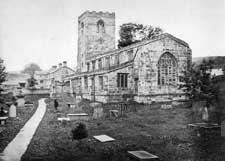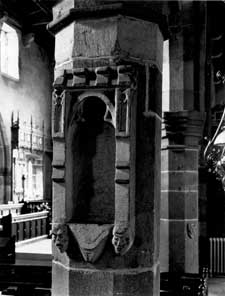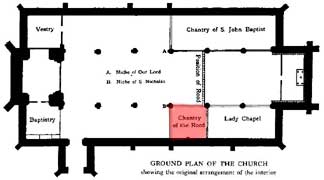- Introduction
- The Chantry School
- KM Free Grammar
- Malham
- Malham Girls School
- Scosthrop
- Malham Tarn
- KM United School
- Airton
- Lee Gate & Bordley
Clicking on most pictures will show a larger version

The Parish Church was the site of the Chantry School providing the first education in Malhamdale

The niche which held the statue of St Nicholas
The History of Education in Malhamdale
The Chantry School (15th
& 16th Centuries)
This is the earliest known school in Malhamdale, believed to be in operation from the 15th century until around 1600, although no exact dates are known. Chantry schools were the most important source of education in the Middle Ages. They were usually grammar schools but were sometimes elementary schools.
The main purpose of a Chantry was for a patron to give land or money to
finance a priest to say masses for the souls of the patrons, their families
or other named persons, but some also had an educational function.
The church history booklet written by the Rev Barron in 1923, shows the
Chantry of the Rood situated in the south aisle of the church, to the
west of the Lady or Lambert Chapel and adjacent to the original rood screen,
hence the name. The pillar on the corner of the Chantry held a statue
of St Nicholas, the patron saint of children, which the scholars would
pass every day on their way to lessons.

Location of the Chantry School
According to Morkill in his book ‘The Parish of Kirkby Malhamdale’
there were at one time three Chantries in the church at Kirkby Malham,
but only one, the Chantry of the Rood with its grammar school, had an
educational function.
Richard Carre was the incumbent in 1545 when an Act appointed commissioners
to survey the parishes and many of the chantries were closed down. Of
the three in the church of Kirkby Malham, only the Chantry of the Rood
was spared, the commissioners stating that:
“The Chantry of the Rood at Kirkby Malhamdale, with the Grammar School there, be continued”. A chantry certificate of the time reports; ‘The incumbent of the seid Roode chaunterie being well lerned and licensed to preache kepith a gramer scoole there, which is necessarie to contynue with the seide Revenue or other stipend for the good educacon of the abboundaunt yought in those rewde parties’.
So the chantry of the Rood was saved and continued to operate as a school.
Unfortunately no records seem to have survived giving the names of pupils,
the curriculum or any other details. The date of its final closure is
not known either, but when he died in 1598, Benjamin Lambert left money
in his will for the founding of a Grammar school, so it is assumed the
Chantry School had closed before or around this date.